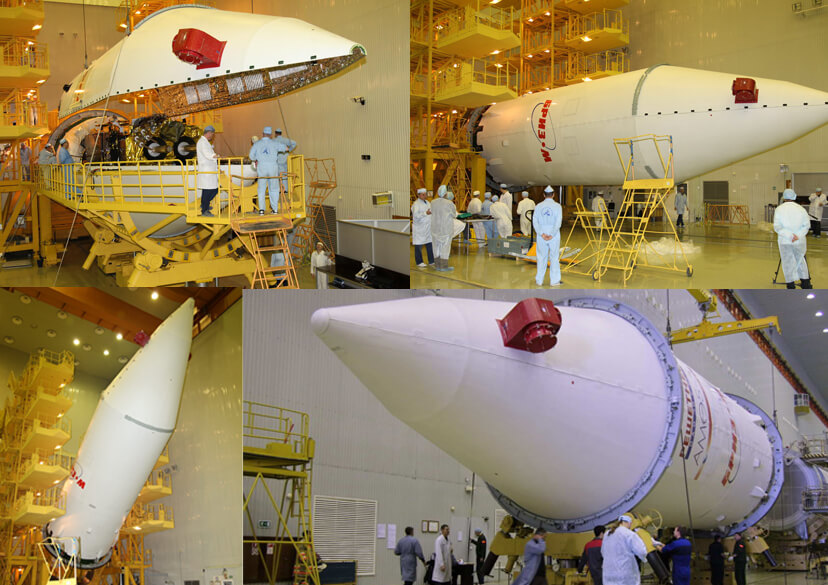The satellite was launched at 13:17 Israel time on a Proton Breeze-M launcher and is now on its way to its orbit above longitude 17° East

Space Communications Company, operator of Amos satellites, announced today that the Amos-5 satellite was launched from Baikonur in Kazakhstan.
The satellite was launched at 13:17 Israel time on a Proton Breeze-M launcher and is now on its way to its orbit above latitude 17° East. Amos-5 is scheduled to separate from the last stage of the launcher about nine and a half hours after launch, then deploy its solar panels.
In the coming weeks, the satellite will undergo a series of tests in orbit, to check the integrity of its various systems (In Orbit Tests), and this is in preparation for the start of its commercial activity.
David Polak, president and CEO of Halal Communications, said today: "The launch of Amos-5 makes Halal a leading multi-regional satellite operator." The launch is an important event for us, and will allow us to provide quality services to the African continent. The satellite will provide us with excellent coverage and capacity designed to respond to the rapidly developing continent. The Communication Space Company is looking forward to the start of its commercial activities, which will enable it to provide quality communication services to the African continent."
Amos-5 will cover the entire African continent, and will provide diverse communication services including TV broadcasts, data and internet. The satellite includes 14 transponders with a bandwidth of 72Mhz and 4 transponders of 36Mhz in the C Band area, and 18 transponders of 72Mhz in the Ku Band area.
Amos-5 joins the two communication satellites of the communication space - Amos-2 and Amos-3, with the latter two located at a strategic point 4° west. The three satellites will provide coverage to some of the most developing markets in the world today, where there is a growing demand for satellite services. These areas include the Middle East, Eastern and Central Europe and, as mentioned, the African continent.
technical details:
The weight of the satellite: 1.9 tons (compared to the weight of 1.3 tons of Amos-3)
Power of the communication system: 5600 watts (compared to 1800 watts in Amos-3)
Number of antennas: 4 large antennas (in relation to 3 large and 3 small antennas in Amos-XNUMX)
Life span: 15 years
Launcher:
The satellite will be launched by the four-stage Proton launcher (called Proton Breeze-M). This launcher has so far launched over 365 times since 1965 with a weighted success rate of 97%. The launcher is 58 meters tall, 7.4 meters in diameter and weighs over 700 tons at launch.
The beginning of the life of Amos-5:
Nine and a half hours after launch, and after separation from the launcher, the satellite is expected to perform the following actions:
- About a minute and a half after separation - the first transmission from the satellite will be received
- About 5 minutes after separation - the solar panels that provide the satellite with energy from the sun will be deployed
- About 5 hours after separation - the communication antennas will be deployed (according to an order from the ground)
These days, the work continues in the aerospace industry on the Amos-4 satellite which, with the expected start of its commercial operation in 2013, will provide services in Russia and South Asia. At the same time, the company is characterizing the Amos-6 satellite which is planned for launch in 2014. This satellite is planned to provide services in Europe, the Middle East and Africa. In doing so, Halal-Communications will in fact expand and establish its multi-regional deployment and its position as a leading satellite operator.

5 תגובות
A geostationary communication satellite always sits at latitude 0. The Amos 5 satellite sits at a longitude (not latitude) of
17 degrees east.
Amos-4 is under construction.
Robby, if you mean collecting solar energy and sending it to the ground using an electromagnetic beam (I think) then the idea is familiar, in one of the episodes on the Discovery Channel they even tested and saw that it works, even very well (the beam is so strong that they fear that if it is directed accidentally or not accidentally towards some settlement She will simply vaporize every living thing that hangs around there)
I would like to test on the next satellite a new idea for energy supply, is it possible?
Amos 5 is launched before Amos 4???